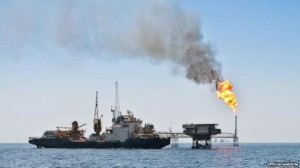 An Iranian oil tanker docks with and oil facility owned by the Iranian National Oil Company in the Persian Gulf.[/caption]
An Iranian oil tanker docks with and oil facility owned by the Iranian National Oil Company in the Persian Gulf.[/caption]Global sanctions cut Iran's crude oil exports by 39% in 2012, to 1.5 million barrels a day, the lowest level since 1986, during the Iran-Iraq war, the U.S. Energy Information Administration said Friday.
Tighter restrictions on Iranian oil sales, led by the U.S. and the European Union, cut Iran's net oil export revenue by 27.4% in 2012 from a year earlier, to $69 billion, the EIA said. Based on earlier estimates from EIA that revenue figure would be the lowest for Iran since 2009, when oil prices were some 56% below the 2012 level.
EIA's assessment on Iran oil revenue and income cover crude oil and condensate, which is produced in association with natural gas and can be substituted for crude oil in some cases.
Sanctions on Iran took hold in 2011 and were tightened in 2012, and included an EU embargo on Iran's oil imports, over concerns that Iran's nuclear efforts went beyond Tehran's proclaimed efforts to establish a peaceful, nuclear-power program.
Iran's oil exports are estimated to make up 80% of Iran's total export earnings and 50% to 60% of government revenue, the EIA said, citing the Economist Intelligence Unit.
"Sanctions affecting investment in Iran's oil sector have also been tightened, resulting in cancellation of new projects by several foreign companies" as well as negatively affecting existing projects, the EIA said.
Iran, once the second-biggest oil producer in the Organization of the Petroleum Exporting Countries after Saudi Arabia, ranked third in the group behind the Saudis and Iraq in April, the EIA said in separate report. Iran's oil output averaged 2.8 million barrels a day in March and April, down 500,000 barrels a day from the same period in 2012.
Iran's total output of crude oil and refined products was estimated at 3.4 million barrels a day in the latest two months, down 400,000 barrels a day from a year earlier. Domestic fuel consumption averaged 1.7 million barrels a day, unchanged from March-April 2012, the EIA said.
"Following the implementation of sanctions in late-2011 and mid-2012, Iranian oil production dropped dramatically. Although Iran had been subject to four earlier rounds of United Nations sanctions, these much-tougher measures passed by the United States and the European Union have severely hampered Iran's ability to export its oil, which directly affected its production of petroleum and petroleum products," the EIA said..
"The U.S. and EU measures prohibited large-scale investment in the country's oil and gas sector, and cut off its access to European and U.S. sources of financial transactions. Further sanctions were implemented against the Central Bank of Iran, while the EU imposed an embargo on Iranian oil and banned European protection and indemnity clubs from providing Iranian oil carriers with insurance and reinsurance. The implementation of insurance-related sanctions was particularly effective in stemming Iranian exports, which affected not only European importers but also Iran's Asian customers who were forced to temporarily halt imports," the EIA said.
The 39% cut in 2012 oil exports "was coupled with a 17% drop in crude oil and condensate production and a 1% decline in liquid fuels consumption including gasoline, diesel, jet fuel, and other products," the EIA said.
Iran's revenue drop came the price of OPEC's reference basket of crude oil set a record high at $109.45 a barrel in 2012, up 1.9% from 2011. In 2009, when Iran's oil revenues were last lower than in 2012, the OPEC basket price averaged $53.50 a barrel, according to the OPEC Secretariat.
By Fox Business
The Iran Project is not responsible for the content of quoted articles.










